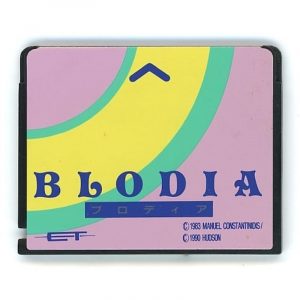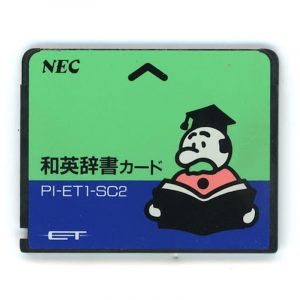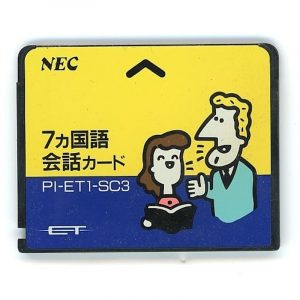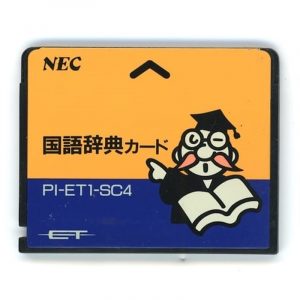|
History
Founded on July 17, 1899, the Nippon Electric Company (NEC) was one of the leading manufacturers of electronic components in Japan. With the technological advance, NEC started to explorer new field of activities such as Mainframe in the 1950s, personal computers in the 1970s and later in the home console market in 1987 with the release of the PC Engine (named the TurboGrafx-16 in North America or simply the TurboGrafx in the UK). The PC Engine hardware was in fact developed in collaboration with Hudson Soft under the codename “C62 System”. The collaboration with Hudson Soft would continue as they would also collaborate to create the PC-FX, the failed successor to the PC Engine, and multiple games for both systems.
Around the same time, Sharp took the world by surprise with the release of a series of Personal Organizers that support program expansion card. The Sharp series of organizers took the PDA concept to a whole new level, sparking the interest of many new consumers. Casio, which was the undeniable king of the personal organizers before the release of the Sharp PA-7000, responded with their own line of personal organizer that supports expansion cards with the release of the DK-5000. With the new craze around the personal organizers, NEC decided to jump into the ring swinging. NEC was already the maker of the PC-98, one of Japan most popular computer line, so why not create a PDA that can interface with it?
It was on that compatibility premise that NEC started to design the PI-ET1 (for Electronic Tool). The PI-ET1 was set to be the most powerful and versatile electronic organizer on the market. To develop the extensive built-in software functionalities, NEC reached out to Hudson Soft.
Release
Released in the first quarter of 1990, the PI-ET1 had everything to be a tremendous success. The device had a160x64 dot matrix LCD display, a bar code scanner, 4-directional pad and 32K of RAM which could be upgraded using the expansion cards (also called IC cards). More importantly, the device used a Z80-compatible CPU, which made it easy for third parties to develop for the system. The μPD70008AC processed used by the PI-ET1 was the same used in PC-88 series of desktops made by NEC,
The PI-ET1 was also the first electronic organizer with a BIOS/OS. Developed by Hudson Soft, the ET-BIOS provided a lot of software functionality such as a built-in 48,000 words dictionary, notepad, spreadsheet, world clock, password management, contact list, etc. It even features an avatar editor to assign each contact with a face. The BIOS also provided all the functionality for developers to access the memory, bar codes scanner, file system, etc. Out of the box, the PI-ET1 also feature their own variation on the BASIC programming language called the ET-BASIC, that allowed users to code their own program.
The handheld was also compatible with NEC’s PC-98, allowing for file synchronization, download of new programs, etc.
Demise
The PI-ET1 should have been a raging success, but it didn’t live up to the expectation. Although NEC had a stellar brand recognition generally in electronic, it was very late in the game to enter the electronic organizer market. Sharp and Casio were already dominating this market since 1983. They each had a large number of IC Cards released for their respective organizer lines, which give them an advantage over any newcomers to the market. To overcome this, NEC released eleven IC Cards in the days/weeks following the release of the PI-ET1. While the number of IC Cards was really adequate for a launch, the diversity was somewhat lacking with three of the cards being RAM extension, four being dictionaries and the last four being games.
The marketing was also another issue, with the PI-ET1 only appearing in the footnotes of some stores ads. Should NEC have been more aggressive with the marketing and with the released of expansion cards, they might have ended up taking a leadership position in the market. Instead, NEC seems to have abandoned fairly quickly the PI-ET1 after it failed to generate the buzz they were hoping for. Instead, NEC put its effort on their next released, the NEC Handy 98 PC98HA, a DOS-based palmtop made exclusively for a Japanese audience.
Games
Although the PI-ET1 didn’t release a lot of software, it is interesting to realize that half of the software released for the device are games (if we exclude the 3 RAM expansion cards that are not a software per se). It’s also interesting to know that the PI-ET1 was released before the PC Engine GT (TurboExpress), making the PI-ET1 the first NEC portable “gaming” device. Since the list of software is so small, I listed below all of the IC Cards available for the PI-ET1, but obviously only the four first software are games.










